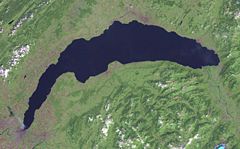Lake Geneva
| Lake Geneva | |
|---|---|
 |
|
| Location | Switzerland, France |
| Primary inflows | Rhone, Venoge, Dranse, Aubonne |
| Primary outflows | Rhone |
| Catchment area | 7,975 km² (3,079 mi²) |
| Basin countries | Switzerland, France |
| Max. length | 73 km (45 mi) |
| Max. width | 14 km (8.7 mi) |
| Surface area | 582 km² (225 mi²) |
| Average depth | 154.4 m |
| Max. depth | 310 m |
| Water volume | 89 km³ |
| Residence time (of lake water) | 11.4 years |
| Surface elevation | 372 m |
| Islands | Ile de la Harpe, Ile de Peilz (islets) |
| Settlements | Geneva (CH), Lausanne (CH), Evian (F), Montreux (CH), Thonon (F), Vevey (CH) (see list) |
Lake Geneva or Lake Léman (French: Lac Léman, Léman, Lac de Genève) is the second largest freshwater lake in Central Europe in terms of surface area (after Lake Balaton). 60% of it comes under the jurisdiction of Switzerland (cantons of Vaud, Geneva, and Valais), and 40% under France (Haute-Savoie).
The crescent-shaped lake, formed by a withdrawing glacier, narrows around Yvoire on the southern shore, the lake can thus be divided into the "Grand Lac" (Large Lake) to the east and the "Petit Lac" (Small Lake) to the west.
It lies on the course of the Rhône River. The river has its source at the Rhone Glacier near the Grimsel Pass to the east of the lake and flows down through the Canton of Valais, entering the lake between Villeneuve and St. Gingolph, before flowing slowly towards its egress at Geneva. Other tributaries are La Dranse, L'Aubonne, La Morges, Venoge, and Veveyse.
The Lake Geneva has an alpine character. The Chablais Alps border its southern shore, the western Bernese Alps lie over its eastern side. The high summits of Grand Combin and Mont Blanc are even visible from a few places.
By the 1960s, the lake had ceased being a transport artery for commercial and construction materials. In the late 1960s pollution made it dangerous to swim at some beaches of the lake; indeed, tourists taking a ride in the local submarine had near zero visibility (it was eventually sold). By the 1980s, intense environmental pollution (eutrophication) had almost wiped out all the fish. Today, pollution levels have been dramatically cut back, and it is again considered safe to swim in the lake. Major leisure activities practiced include sailing, wind surfing, boating (including water skiing and wakeboarding), rowing, scuba diving and bathing.
As an interesting historical and scientific footnote, in 1827, Lake Geneva was the site for the first measurement of the speed of sound in (fresh) water. French mathematician Jacques Charles François Sturm and Swiss Physicist Daniel Collodon used two moored boats, separated by a measured distance, as the transmit and receive platforms for the sounds of exploding gunpowder. The loud airborne sound coupled into the lake, establishing a loud underwater sound that could be measured at a distance. The flash of the exploding gunpowder provided the visual starting cue for the timepiece, and the underwater explosion sound striking a bell provided the finish cue.
The shore between Nyon and Lausanne is called La Côte because it is "flatter". Between Lausanne and Vevey it is called Lavaux and is famous for its hilly vineyards.
Contents |
Name

The first recorded name of the lake is Lacus Lemannus from Roman times; it became Lacus Lausonius, although this name was also used for a town or district on the lake, Lacus Losanetes and then the Lac de Lausanne in the Middle Ages. Following the rise of Geneva it became Lac de Genève (translated into English as Lake Geneva). In the 18th century, Lac Léman was revived in French. It is often called Lac de Genève in Geneva [1][2] and Lac Léman elsewhere but the customary name in French is now Lac Léman. Certain maps name the lake the Lac d'Ouchy (after the port located on the Lausanne lake shore). In contemporary English, the name Lake Geneva is predominant.
A note on pronunciation (in the IPA) —
- English: Lake Geneva /leɪk dʒəˈni:və/
- French: Lac Léman [lak leˈmɑ̃] or Lac de Genève [lak dø ʒøˈnɛv]
- German: Genfersee or Genfer See [ˈgɛnfəʁˈzeː]
- Italian: Lago Lemano, Lago di Ginevra [ˈlago di dʒiˈnɛvra].
Miscellaneous
- Mary and Percy Shelley and Lord Byron holidayed by the lake and wrote ghost stories; one of which was the basis for the novel Frankenstein.
- Vladimir Lenin rented a little "chalet" at the French bank, near Geneva.
- Pop singer Phil Collins lives in a home overlooking the lake.
- Ex-Formula 1 driver Michael Schumacher lives with his family in a home overlooking the lake.
Cities and places


| Southern shore | Northern shore | |
|---|---|---|
| Grand Lac |
|
|
| Petit Lac |
|
|
References
External links
- International Commission for the Protection of Lake Geneva (CIPEL)
- Lake Geneva in German, French and Italian in the online Historical Dictionary of Switzerland.
- Les ports du lac Léman (French) guide to the lake's harbours
- CGN Compagnie Générale de Navigation sur le lac Léman
- www.plongee-passion.ch (French) A site with stacks of information for scuba diving
- The official site of the Geneva police of the lake with lots of information
- Waterlevels Lake Geneva at Chillon
- Waterlevels Lake Geneva at Saint-Prex
- Waterlevels Lake Geneva at Geneva